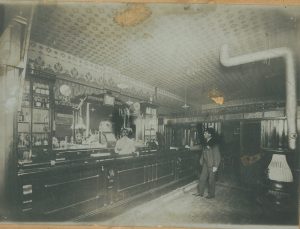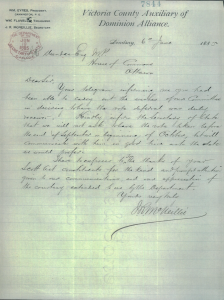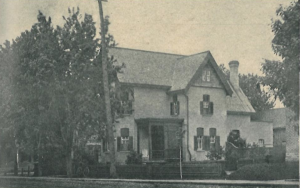Temperance
From their earliest years, Dorothea would instill in each of her children the moral dedication to abstain from liquor.

The Royal Hotel bar room located at the corner of Kent and Lindsay Streets. Thomas McConnell, owner, was frequently targeted during prohibition years. ca. 1900s.
Liquor — cheap, strong, and easily accessible — was a force to be reckoned with in Canada in the late nineteenth and early twentieth century and a source of instability in the Flavelle family. The Flavelles felt strongly enough about temperance that Dorothea Flavelle required all employees of her sons’ businesses to be abstainers. Dorothea was a local organizer with the Women’s Christian Temperance Union. with William and J. D. rallying support among leading businessmen as part of Victoria County Scott Act auxiliary.

Letter sent to J. R. Dundas, MP thanking him for moving quickly on securing a vote in Victoria County to prohibit alcohol. June 6, 1885.
The Scott Act, which would allow municipalities to enact prohibition through plebiscite, was a significant part of the movements for temperance and regulating liquor. Ardent temperance organizers, including those in Victoria County, drummed up the support needed to pass the Act. The Scott Act passed by the federal government in 1878, the same year that J. D. Flavelle won a seat on Lindsay’s Council. By April, as the Finance Chair, J. D. tried his best to amend the license fee for tavern owners – to no avail, due to technicalities of the by-laws at the time.
After the passage of the Scott Act, temperance workers worked hard to turn Victoria County “dry.” J. R. Dundas, the Flavelle brothers’ uncle, was elected to represent Victoria South in the House of Commons in the 1882 federal election. Although a backbencher, he did have some effect in getting a plebiscite vote in his riding working with William, who at the time was the Secretary of the Victoria County Scott Act Auxiliary. When the plebiscite vote was held on July 23, 1885, the majority of folks voted in favour of restricting alcohol. Notably, only Lindsay and the township of Ops voted against prohibiting liquor. The local option/prohibition proved effective in some regard when it came to regulating taverns and hotel keepers illegally selling alcohol. Individual fines were not high enough to prove a true barrier to continued sales or consumption.

Dorothea Flavelle’s home that J. D. and William built for her after William married Mary Aird in 1886. Located at the southeast corner on Cambridge and Peel Streets. William’s house was located directly north of this home on the northeast corner of Cambridge and Peel Streets and it’s from a north window where either Mary or Margaret Flavelle saw a fire ablaze on their brother’s porch. 1898.
The battle over prohibition reached a peak in January of 1888 when an arsonist set William’s Peel Street house ablaze. Moments later, after the verandah was extinguished, the arsonist hastily attempted to ignite the Dundas & Flavelle Bros. dry goods store. Nobody was harmed, and this incident did not sway William nor J. D.’s desire to prohibit the sale of alcohol.

